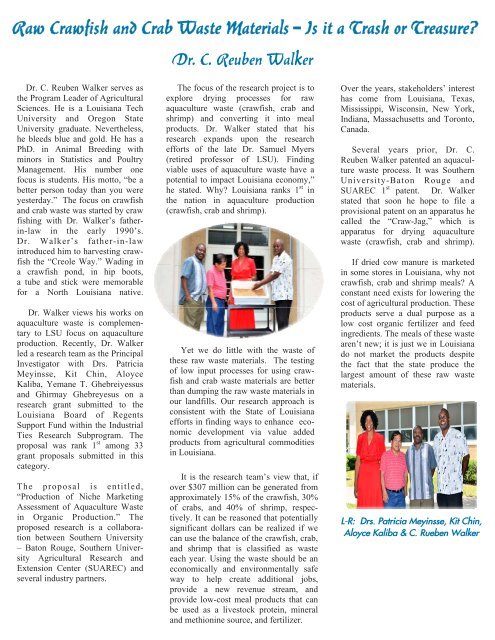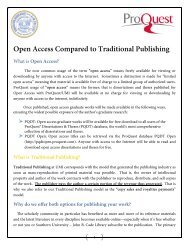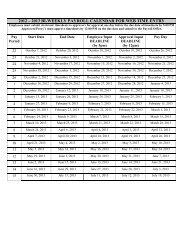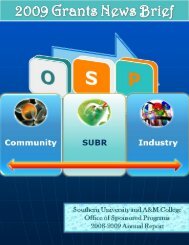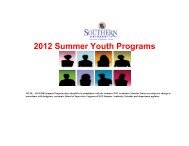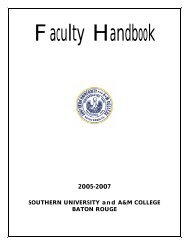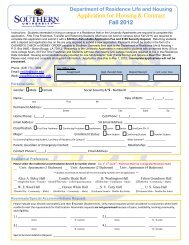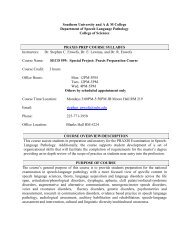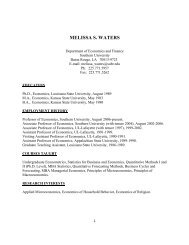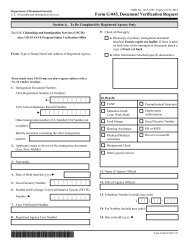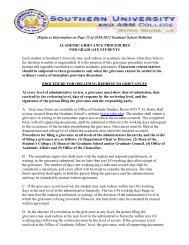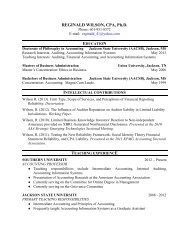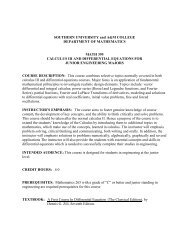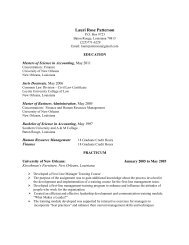12 Newsbrief - Southern University at Baton Rouge
12 Newsbrief - Southern University at Baton Rouge
12 Newsbrief - Southern University at Baton Rouge
Create successful ePaper yourself
Turn your PDF publications into a flip-book with our unique Google optimized e-Paper software.
Raw Crawfish and Crab Waste M<strong>at</strong>erials - Is it a Trash or Treasure?<br />
Dr. C. Reuben Walker<br />
Dr. C. Reuben Walker serves as<br />
the Program Leader of Agricultural<br />
Sciences. He is a Louisiana Tech<br />
<strong>University</strong> and Oregon St<strong>at</strong>e<br />
<strong>University</strong> gradu<strong>at</strong>e. Nevertheless,<br />
he bleeds blue and gold. He has a<br />
PhD. in Animal Breeding with<br />
minors in St<strong>at</strong>istics and Poultry<br />
Management. His number one<br />
focus is students. His motto, “be a<br />
better person today than you were<br />
yesterday.” The focus on crawfish<br />
and crab waste was started by craw<br />
fishing with Dr. Walker’s f<strong>at</strong>herin-law<br />
in the early 1990’s.<br />
Dr. Walker’s f<strong>at</strong>her-in-law<br />
introduced him to harvesting crawfish<br />
the “Creole Way.” Wading in<br />
a crawfish pond, in hip boots,<br />
a tube and stick were memorable<br />
for a North Louisiana n<strong>at</strong>ive.<br />
Dr. Walker views his works on<br />
aquaculture waste is complementary<br />
to LSU focus on aquaculture<br />
production. Recently, Dr. Walker<br />
led a research team as the Principal<br />
Investig<strong>at</strong>or with Drs. P<strong>at</strong>ricia<br />
Meyinsse, Kit Chin, Aloyce<br />
Kaliba, Yemane T. Ghebreiyessus<br />
and Ghirmay Ghebreyesus on a<br />
research grant submitted to the<br />
Louisiana Board of Regents<br />
Support Fund within the Industrial<br />
Ties Research Subprogram. The<br />
proposal was rank 1 st among 33<br />
grant proposals submitted in this<br />
c<strong>at</strong>egory.<br />
The proposal is entitled,<br />
“Production of Niche Marketing<br />
Assessment of Aquaculture Waste<br />
in Organic Production.” The<br />
proposed research is a collabor<strong>at</strong>ion<br />
between <strong>Southern</strong> <strong>University</strong><br />
– B<strong>at</strong>on <strong>Rouge</strong>, <strong>Southern</strong> <strong>University</strong><br />
Agricultural Research and<br />
Extension Center (SUAREC) and<br />
several industry partners.<br />
The focus of the research project is to<br />
explore drying processes for raw<br />
aquaculture waste (crawfish, crab and<br />
shrimp) and converting it into meal<br />
products. Dr. Walker st<strong>at</strong>ed th<strong>at</strong> his<br />
research expands upon the research<br />
efforts of the l<strong>at</strong>e Dr. Samuel Myers<br />
(retired professor of LSU). Finding<br />
viable uses of aquaculture waste have a<br />
potential to impact Louisiana economy,”<br />
he st<strong>at</strong>ed. Why? Louisiana ranks 1 st in<br />
the n<strong>at</strong>ion in aquaculture production<br />
(crawfish, crab and shrimp).<br />
Yet we do little with the waste of<br />
these raw waste m<strong>at</strong>erials. The testing<br />
of low input processes for using crawfish<br />
and crab waste m<strong>at</strong>erials are better<br />
than dumping the raw waste m<strong>at</strong>erials in<br />
our landfills. Our research approach is<br />
consistent with the St<strong>at</strong>e of Louisiana<br />
efforts in finding ways to enhance economic<br />
development via value added<br />
products from agricultural commodities<br />
in Louisiana.<br />
It is the research team’s view th<strong>at</strong>, if<br />
over $307 million can be gener<strong>at</strong>ed from<br />
approxim<strong>at</strong>ely 15% of the crawfish, 30%<br />
of crabs, and 40% of shrimp, respectively.<br />
It can be reasoned th<strong>at</strong> potentially<br />
significant dollars can be realized if we<br />
can use the balance of the crawfish, crab,<br />
and shrimp th<strong>at</strong> is classified as waste<br />
each year. Using the waste should be an<br />
economically and environmentally safe<br />
way to help cre<strong>at</strong>e additional jobs,<br />
provide a new revenue stream, and<br />
provide low-cost meal products th<strong>at</strong> can<br />
be used as a livestock protein, mineral<br />
and methionine source, and fertilizer.<br />
Over the years, stakeholders’ interest<br />
has come from Louisiana, Texas,<br />
Mississippi, Wisconsin, New York,<br />
Indiana, Massachusetts and Toronto,<br />
Canada.<br />
Several years prior, Dr. C.<br />
Reuben Walker p<strong>at</strong>ented an aquaculture<br />
waste process. It was <strong>Southern</strong><br />
<strong>University</strong>-B<strong>at</strong>on <strong>Rouge</strong> and<br />
SUAREC 1 st p<strong>at</strong>ent. Dr. Walker<br />
st<strong>at</strong>ed th<strong>at</strong> soon he hope to file a<br />
provisional p<strong>at</strong>ent on an appar<strong>at</strong>us he<br />
called the “Craw-Jag,” which is<br />
appar<strong>at</strong>us for drying aquaculture<br />
waste (crawfish, crab and shrimp).<br />
If dried cow manure is marketed<br />
in some stores in Louisiana, why not<br />
crawfish, crab and shrimp meals? A<br />
constant need exists for lowering the<br />
cost of agricultural production. These<br />
products serve a dual purpose as a<br />
low cost organic fertilizer and feed<br />
ingredients. The meals of these waste<br />
aren’t new; it is just we in Louisiana<br />
do not market the products despite<br />
the fact th<strong>at</strong> the st<strong>at</strong>e produce the<br />
largest amount of these raw waste<br />
m<strong>at</strong>erials.<br />
L-R: Drs. P<strong>at</strong>ricia Meyinsse, Kit Chin,<br />
Aloyce Kaliba & C. Rueben Walker


